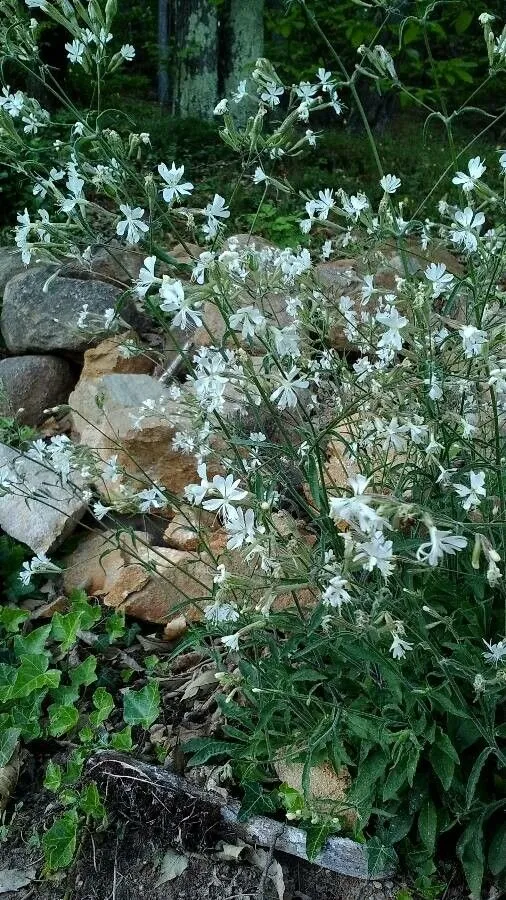
Author: (L.) Pers.
Bibliography: Syn. Pl. 1: 498 (1805)
Year: 1805
Status: accepted
Rank: species
Genus: Silene
Vegetable: False
Observations: S. Europe to W. & N. Iran
The Italian catchfly, known by its scientific name Silene italica, is a captivating herbaceous plant that belongs to the Caryophyllaceae family. Originating from Southern Europe and extending its presence to Western and Northern Iran, this species has a widespread distribution across a diverse range of habitats.
Characterized by its attractive flowers, Silene italica often graces rocky terrains, grassy meadows, and open woodlands, thriving in environments that offer ample sunlight and well-draining soil. The plant typically presents a delicate form, with slender stems that can support exquisite blossoms known for their vibrant and appealing appearance.
Silene italica’s blooms are typically white or pale pink, with a subtle yet enchanting fragrance that draws in pollinators such as bees and butterflies. These petals are often delicate and finely toothed, adding to the overall elegant aesthetic of the plant. The leaves of the Italian catchfly are usually lanceolate, providing a lush green backdrop to the striking floral display.
The plant was formally described in the early 19th century, with its bibliographic reference appearing in “Syn. Pl. 1: 498” in the year 1805. The distinguished botanist (L.) Pers., or Christiaan Hendrik Persoon, was responsible for the formal classification and naming of Silene italica.
Due to its ornamental value and adaptability, the Italian catchfly has found a place in gardens and landscaping projects, especially in regions with climates similar to its native habitats. Gardeners appreciate the plant not only for its beauty but also for its relatively low maintenance requirements, making it a favored choice in creating aesthetically pleasing yet sustainable garden spaces.
Moreover, Silene italica plays a role in local ecosystems by providing nectar sources for pollinators and contributing to the biodiversity of the flora in its native regions. The plant’s ecological contributions, combined with its botanical allure, underscore its significance both in natural settings and cultivated landscapes.
In summary, Silene italica or the Italian catchfly is a noteworthy representative of the Caryophyllaceae family, admired for its decorative flowers and resilience. Its origins spanning Southern Europe to parts of Iran, along with its formal description dating back to the early 19th century, highlight its enduring presence and botanical appeal.
Eng: italian catchfly
Deu: italienisches leimkraut
Dan: italiensk limurt
Nld: italiaanse silene
Swe: romarglim
Nno: romarsmelle
Nob: romersmelle
Cym: gludlys yr eidal
En: Italian catchfly
Ar: سيلينة إيطالية
Az: İtaliya qoyunqulağı
Ca: Silene itàlica
Da: Italiensk limurt
Nl: Italiaanse silene
Fr: Silène d’Italie
De: Italienisches Leimkraut
He: ציפורנית איטלקית
It: Silene italiana
Nb: Romersmelle
Nn: Romarsmelle
Pl: Lepnica południowa
Sv: Romarglim
Uk: Смілка італійська
Cy: Gludlys yr Eidal
Taken May 3, 2022 by Jean-Luc Savornin (cc-by-sa)
Taken May 1, 2011 by Tela Botanica − Paul FABRE (cc-by-sa)
Taken Apr 29, 2021 by Daniel Barthelemy (cc-by-sa)
Taken Apr 17, 2019 by Mathieu VALENTIN (cc-by-sa)
Taken Apr 30, 2021 by Albert Mallol Camprubí (cc-by-sa)
Taken Jun 5, 2020 by Llandrich anna (cc-by-sa)
Taken Jun 17, 2021 by Llandrich anna (cc-by-sa)
Taken Apr 17, 2022 by cirse (cc-by-sa)
Taken May 1, 2011 by Tela Botanica − Paul FABRE (cc-by-sa)
Taken Apr 29, 2021 by Daniel Barthelemy (cc-by-sa)
Taken May 26, 2019 by olivier (cc-by-sa)
Taken May 23, 2015 by Tela Botanica − Yoan MARTIN (cc-by-sa)
Taken Apr 20, 2022 by Clement Devaux (cc-by-sa)
Taken Apr 29, 2021 by Daniel Barthelemy (cc-by-sa)
Taken Apr 29, 2021 by Daniel Barthelemy (cc-by-sa)
Taken Feb 13, 2018 by Tela Botanica − Liliane ROUBAUDI (cc-by-sa)
Taken Feb 13, 2018 by Tela Botanica − Liliane ROUBAUDI (cc-by-sa)
Taken Feb 13, 2018 by Tela Botanica − Liliane ROUBAUDI (cc-by-sa)
Taken Jan 14, 2022 by Frédéric Loyez (cc-by-sa)
Taken Aug 7, 2017 by huy HO (cc-by-sa)
Taken Nov 26, 2022 by Daniel Bourget (cc-by-sa)
Taken Jun 17, 2021 by Llandrich anna (cc-by-sa)
Taken Apr 29, 2021 by Daniel Barthelemy (cc-by-sa)
Taken Apr 30, 2022 by Jan Syben (cc-by-sa)
Taken Apr 20, 2022 by Clement Devaux (cc-by-sa)
Taken Apr 15, 2012 by Photoflora – Benoit BOCK (©)
Taken Apr 26, 2011 by Tela Botanica − Jean-Pascal MILCENT (cc-by-sa)
Taken Jan 1, 1970 by Photoflora – L’Abbé COSTE (©)
Taken May 15, 2012 by Photoflora – Benoit BOCK (©)
Taken May 1, 2020 by Denis Bastianelli (cc-by-sa)
© copyright of the Board of Trustees of the Royal Botanic Gardens, Kew.
© copyright of the Board of Trustees of the Royal Botanic Gardens, Kew.
Growth habit: Forb/herb
Ph maximum: 8.0
Ph minimum: 7.5
Light: 8
Atmospheric humidity: 4
Soil nutriments: 4
Family: Myrtaceae Author: (F.Muell.) K.D.Hill & L.A.S.Johnson Bibliography: Telopea 6: 402 (1995) Year: 1995 Status:…
Family: Rubiaceae Author: Pierre ex A.Froehner Bibliography: Notizbl. Bot. Gart. Berlin-Dahlem 1: 237 (1897) Year:…
Family: Sapindaceae Author: Koidz. Bibliography: J. Coll. Sci. Imp. Univ. Tokyo 32(1): 38 (1911) Year:…
Family: Asteraceae Author: A.Gray Bibliography: Pacif. Railr. Rep.: 107 (1857) Year: 1857 Status: accepted Rank:…
Family: Fabaceae Author: Medik. Bibliography: Vorles. Churpfälz. Phys.-Ökon. Ges. 2: 398 (1787) Year: 1787 Status:…
Family: Aspleniaceae Author: (Cav.) Alston Bibliography: Bull. Misc. Inform. Kew 1932: 309 (1932) Year: 1932…